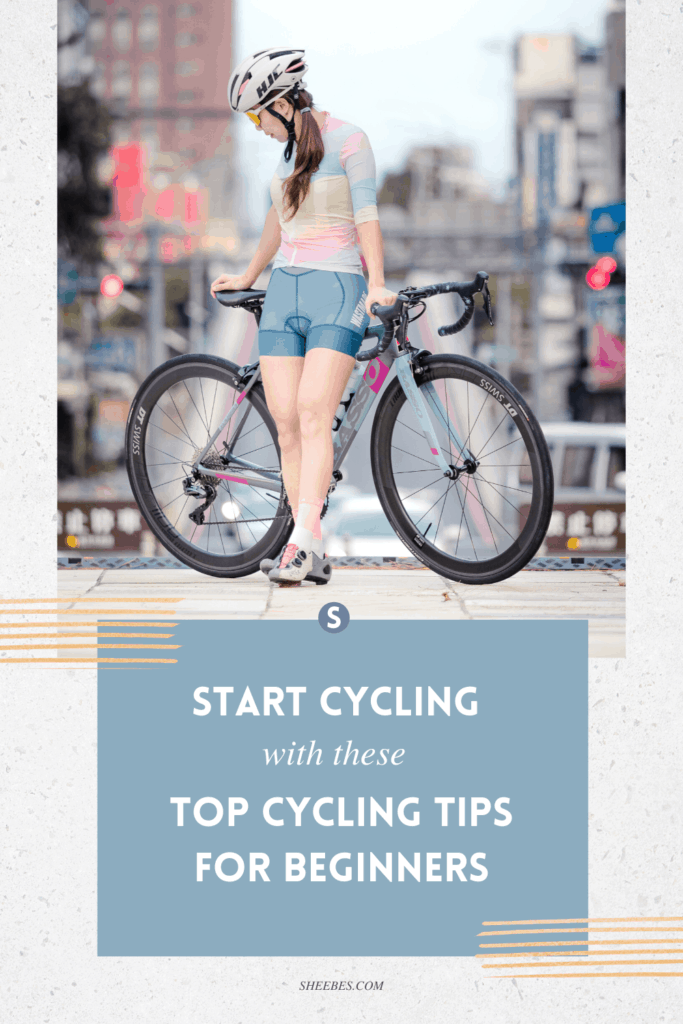Have you begun your research into cycling but have gotten overwhelmed by all the road cycling tips for beginners?
What bike do I need to start cycling?
Why is there so much cycling gear and do I really need all these cycling accessories?
How often should I ride my bike?
Good questions…and if you’re looking for road cycling tips for beginners, then keep reading because you’ll find answers to those questions and more here.
Let’s get started.

Whether you’re a runner looking for running tips or a cyclist searching for cycling advice, this site is here to help you elevate your fitness game.

Affiliate Disclosure: I’m here to help you grow as a rider and runner. So to keep things running smoothly and the content free, I participate in the Amazon Services program and select affiliate networks. So, when you click on those affiliate links, I earn a small commission at no extra cost to you.
THE TOP ROAD CYCLING TIPS FOR BEGINNERS

Go to your local bike shop to test ride a few road bikes
Visiting a local bike shop gives you a chance to ask questions, and test ride a few bikes in various sizes.
Before your visit, it may be helpful for you to consider these 3 questions:
- What’s your budget?
- What’s your riding history?
- What are your biking goals? Do you want to ride mostly on roads? Mountain trails?
These questions help narrow down the field to a handful of bikes to test ride.
Try a few bikes in different sizes and sitting positions to pin down what’s comfortable for you.
You may have even more questions while you’re at the bike shop, so look for a bike shop that makes you feel comfortable and encourages you to ask questions.
You’re investing a good chunk of change on a bike (and future repairs), so a salesperson should not make you feel silly for asking questions.

Get comfortable riding your road bike
Get a bike fit. Much like tailoring a suit to fit you, a bike fit does the same—fits your bike to your body.
Some people may need a lower saddle height (or an entirely different saddle), while others may need to move the brake levers closer to fit small hands.
Whatever your proportions are, a bike fit makes riding your bike feel comfortable and more like a natural extension of your body.
Padded bike shorts. Bike shorts, made with wicking fabric, provide cushioning in the groin area to relieve pressure and make cycling more comfortable.
And if you plan on riding regularly (or notice that you’re highly uncomfortable while cycling), a pair of padded bike shorts can help, making it much more enjoyable to ride.
Bike shorts come in many lengths and cuts but look for ones that don’t squeeze your waist, especially when you’re hunched over on your bike.
Quick note: Wear bike shorts without underwear, to reduce chafing.
Go ride. Find a bike-only path so you can focus on cycling, away from traffic.
And if you’re riding your bike alone, you’ll find cycling alone tips here.
Practicing cycling skills may probably be low on your list of fun things to do on your bike, but these two cycling skills can help you prevent unnecessary accidents.
- Sighting. Did you know that your bike goes where you look? If you’re looking at a huge rock that’s in your way, your bike will, unfortunately, run into that rock. Look ahead at where you want to go, and your bike will follow.
- Braking. Practice using your brakes so that you can become comfortable and adept at stopping your bike without tipping over or crashing.
Your bike has two brakes—a front brake and a rear brake. Get to know which brake lever controls the front and which lever controls the back.
Your rear brake slows your speed gradually.
Your front brakes bring you to a complete stop.
WARNING! You have to be prepared to come to a sudden stop if you pull hard on your front brakes.

What are the cycling accessories you need as a new cyclist? These are the essentials
Helmet. A helmet is crucial, and depending on your country, wearing one may be a legal requirement.
Front and rear lights. Like helmets, front and back bike lights may be required depending on your country and local state laws.
Extra bike tubes in case of a flat tire. Not sure how to fix a flat tire? This video may help.
Cycling first aid kit for any unexpected accidents and minor injuries. Brave Soldier Crash Pak First Aid Kit and Cycling First Aid Kit.
Bike pump. A small portable bike pump ( Pro Bike Tool Mini Bike Pump) can get you back on the road quickly if your tires are running out of air.
Clipless pedals and cycling shoes. Cycling shoes and pedals work together as a system to click and lock into place.
Cycling shoes have a stiff sole that secures your feet to the pedal to prevent your feet from flying off your pedal.
Getting out of clipless pedals takes a bit of time to get used to because it’s an unfamiliar motion—flicking your ankle out—to release your shoes from the pedal.
You can master clipping in and out of these pedals if you secure your bike to an indoor trainer.
If you’re looking for a budget bike trainer, then this post might help.

How often should you cycle a week?
Ready to start cycling? If you haven’t been cycling regularly, then begin by building your cycling fitness with 30-minute rides, three times a week.
And if you have time, continue to extend your time riding your bike by about 10% every week.
As you increase your cycling time and distance, be sure to weave in a rest day—a day of no cycling—to give your body and mind a break.
If you’re looking for a structured road cycling training plan for beginners…
Training Plans for Cyclists, Gale Bernhardt
Whether your goal is to ride for 30-miles or do a one-week tour, this book has 16 road cycling training plans for beginners that can help you reach your cycling goal.
Don’t have time for an outdoor bike ride?
You may want to consider indoor cycling, where you get to work out on your own time and stay safe at home.
You’ll find indoor cycling tips for beginners here along with indoor cycling training plans, and cycling training apps to keep you motivated.
Conclusion
We’ve run through a handful of cycling tips for beginners in this post, but this—the cycling gear and building your fitness—is just the beginning.
You also need to train your mind because your mind can motivate you to ride your bike or cause you to call it quits.
The good news is, building mental toughness doesn’t require a massive amount of time, nor is it difficult or complicated.